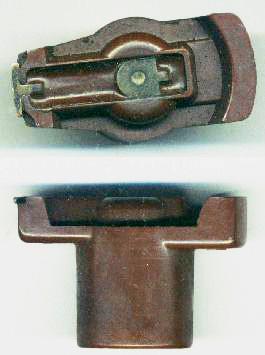|
50C5
The term All American Five (abbreviated AA5) is a colloquial name for mass-produced, Superheterodyne receiver, superheterodyne radio receivers that used five vacuum tubes in their design. These radio sets were designed to receive amplitude modulation (AM) broadcasts in the medium wave band, and were manufactured in the United States from the mid-1930s until the early 1960s. By eliminating a power transformer, cost of the units was kept low; the same principle was later applied to television receivers. Variations in the design for lower cost, shortwave bands, better performance or special power supplies existed, although many sets used an identical set of vacuum tubes. Philosophy The radio was called the "All American Five" because the design typically used five vacuum tubes, and comprised the majority of radios manufactured for home use in the USA and Canada in the tube era. They were manufactured in the millions by hundreds of manufacturers from the 1930s onward, and the las ... [...More Info...] [...Related Items...] OR: [Wikipedia] [Google] [Baidu] |
Superheterodyne Receiver
A superheterodyne receiver, often shortened to superhet, is a type of radio receiver that uses frequency mixing to convert a received signal to a fixed intermediate frequency (IF) which can be more conveniently processed than the original carrier frequency. It was invented by French radio engineer and radio manufacturer Lucien Lévy. Virtually all modern radio receivers use the superheterodyne principle. Precursors Early radio Early Morse code radio broadcasts were produced using an alternator connected to a spark gap. The output signal was at a carrier frequency defined by the physical construction of the gap, modulated by the alternating current signal from the alternator. Since the output frequency of the alternator was generally in the audible range, this produces an audible amplitude modulated (AM) signal. Simple radio detectors filtered out the high-frequency carrier, leaving the modulation, which was passed on to the user's headphones as an audible signal of do ... [...More Info...] [...Related Items...] OR: [Wikipedia] [Google] [Baidu] |
Electronic Oscillator
An electronic oscillator is an electronic circuit that produces a periodic, oscillating or alternating current (AC) signal, usually a sine wave, square wave or a triangle wave, powered by a direct current (DC) source. Oscillators are found in many electronic devices, such as radio receivers, television sets, radio and television broadcast transmitters, computers, computer peripherals, cellphones, radar, and many other devices. Oscillators are often characterized by the frequency of their output signal: *A low-frequency oscillator (LFO) is an oscillator that generates a frequency below approximately 20 Hz. This term is typically used in the field of audio synthesizers, to distinguish it from an audio frequency oscillator. *An audio oscillator produces frequencies in the audio range, 20 Hz to 20 kHz. *A radio frequency (RF) oscillator produces signals above the audio range, more generally in the range of 100 kHz to 100 GHz. There are two ge ... [...More Info...] [...Related Items...] OR: [Wikipedia] [Google] [Baidu] |
Morse Code
Morse code is a telecommunications method which Character encoding, encodes Written language, text characters as standardized sequences of two different signal durations, called ''dots'' and ''dashes'', or ''dits'' and ''dahs''. Morse code is named after Samuel Morse, one of the early developers of the system adopted for electrical telegraphy. International Morse code encodes the 26 ISO basic Latin alphabet, basic Latin letters to , one Diacritic, accented Latin letter (), the Arabic numerals, and a small set of punctuation and procedural signals (Prosigns for Morse code, prosigns). There is no distinction between upper and lower case letters. Each Morse code symbol is formed by a sequence of ''dits'' and ''dahs''. The ''dit'' duration can vary for signal clarity and operator skill, but for any one message, once the rhythm is established, a beat (music), half-beat is the basic unit of time measurement in Morse code. The duration of a ''dah'' is three times the duration ... [...More Info...] [...Related Items...] OR: [Wikipedia] [Google] [Baidu] |
Beat Frequency Oscillator
In a radio receiver, a beat frequency oscillator or BFO is a dedicated electronic oscillator, oscillator used to create an audio frequency signal from Morse code radiotelegraphy (Continuous wave, CW) transmissions to make them audible. The signal from the BFO is mixed with the received signal to create a heterodyne or Beat (acoustics), beat frequency which is heard as a tone in the speaker. BFOs are also used to demodulate single-sideband modulation, single-sideband (SSB) signals, making them intelligible, by essentially restoring the carrier wave, carrier that was suppressed at the transmitter. BFOs are sometimes included in communications receivers designed for short wave listeners; they are almost always found in communication receivers for amateur radio, which often receive CW and SSB signals.Larry Wolfgang, Charles Hutchinson (ed), ''The ARRL Handbook for Radio Amateurs Sixty Eighth Edition'', ARRL, -9, pages 12-29,12-30 The beat frequency oscillator was invented in 1901 by C ... [...More Info...] [...Related Items...] OR: [Wikipedia] [Google] [Baidu] |
Push–pull Output
A push–pull amplifier is a type of electronic circuit that uses a pair of active devices that alternately supply current to, or absorb current from, a connected load. This kind of amplifier can enhance both the load capacity and switching speed. Push–pull outputs are present in Transistor-transistor logic, TTL and CMOS digital logic circuits and in some types of electronic amplifier, amplifiers, and are usually realized by a complementary pair of transistors, one dissipating or ''sinking'' current from the load to ground or a negative power supply, and the other supplying or ''sourcing'' current to the load from a positive power supply. A push–pull amplifier is more efficient than a single-ended Power amplifier classes#Class A, "class-A" amplifier. The output power that can be achieved is higher than the continuous dissipation rating of either transistor or tube used alone and increases the power available for a given supply voltage. Symmetrical construction of the two ... [...More Info...] [...Related Items...] OR: [Wikipedia] [Google] [Baidu] |
Radio Frequency
Radio frequency (RF) is the oscillation rate of an alternating electric current or voltage or of a magnetic, electric or electromagnetic field or mechanical system in the frequency range from around to around . This is roughly between the upper limit of audio frequencies that humans can hear (though these are not electromagnetic) and the lower limit of infrared frequencies, and also encompasses the microwave range. These are the frequencies at which energy from an oscillating current can radiate off a conductor into space as radio waves, so they are used in radio technology, among other uses. Different sources specify different upper and lower bounds for the frequency range. Electric current Electric currents that oscillate at radio frequencies (RF currents) have special properties not shared by direct current or lower audio frequency alternating current, such as the 50 or 60 Hz current used in electrical power distribution. * Energy from RF currents in conduct ... [...More Info...] [...Related Items...] OR: [Wikipedia] [Google] [Baidu] |
Intermediate Frequency
In communications and electronic engineering, an intermediate frequency (IF) is a frequency to which a carrier wave is shifted as an intermediate step in Transmission (telecommunications), transmission or reception. The intermediate frequency is created by mixing the carrier signal with a local oscillator signal in a process called heterodyning, resulting in a signal at the difference or beat frequency. Intermediate frequencies are used in Superheterodyne receiver, superheterodyne radio receivers, in which an incoming signal is shifted to an IF for Amplifier, amplification before final Detector (radio), detection is done. Conversion to an intermediate frequency is useful for several reasons. When several stages of filters are used, they can all be set to a fixed frequency, which makes them easier to build and to tune. Lower frequency transistors generally have higher gains so fewer stages are required. It's easier to make sharply selective filters at lower fixed frequencies. Ther ... [...More Info...] [...Related Items...] OR: [Wikipedia] [Google] [Baidu] |
Leakage (electronics)
In electronics, leakage is the gradual transfer of electrical energy across a boundary normally viewed as insulating, such as the spontaneous discharge of a charged capacitor, magnetic coupling of a transformer with other components, or flow of current across a transistor in the "off" state or a reverse-polarized diode. In capacitors Gradual loss of energy from a charged capacitor is primarily caused by electronic devices attached to the capacitors, such as transistors or diodes, which conduct a small amount of current even when they are turned off. Even though this off current is an order of magnitude less than the current through the device when it is on, the current still slowly discharges the capacitor. Another contributor to leakage from a capacitor is from the undesired imperfection of some dielectric materials used in capacitors, also known as ''dielectric leakage''. It is a result of the dielectric material not being a perfect insulator and having some non-zero conducti ... [...More Info...] [...Related Items...] OR: [Wikipedia] [Google] [Baidu] |
Underwriters Laboratories
The UL enterprise is a global private safety company headquartered in Northbrook, Illinois, composed of three organizations, UL Research Institutes, UL Standards & Engagement and UL Solutions. Established in 1894, the UL enterprise was founded as the Underwriters' Electrical Bureau (a bureau of the National Board of Fire Underwriters), and was known throughout the 20th century as Underwriters Laboratories. On January 1, 2012, Underwriters Laboratories became the parent company of a for-profit company in the U.S. named UL LLC, a limited liability company, which took over the product testing and certification business. On June 26, 2022, the companies rebranded into three distinct organizations that make up the UL enterprise. The company is one of several companies approved to perform safety testing by the U.S. federal agency Occupational Safety and Health Administration (OSHA). OSHA maintains a list of approved testing laboratories, which are known as Nationally Recognized Testi ... [...More Info...] [...Related Items...] OR: [Wikipedia] [Google] [Baidu] |
Bakelite
Bakelite ( ), formally , is a thermosetting polymer, thermosetting phenol formaldehyde resin, formed from a condensation reaction of phenol with formaldehyde. The first plastic made from synthetic components, it was developed by Belgian chemist Leo Baekeland in Yonkers, New York, in 1907, and patented on December 7, 1909. Bakelite was one of the first plastic-like materials to be introduced into the modern world and was popular because it could be Molding (process), molded and then hardened into any shape. Because of its electrical nonconductor, nonconductivity and heat-resistant properties, it became a great commercial success. It was used in electrical insulators, radio and telephone casings, and such diverse products as kitchenware, jewelry, pipe stems, children's toys, and firearms. The retro appeal of old Bakelite products has made them collectible. The creation of a synthetic plastic was revolutionary for the chemical industry, which at the time made most of its income f ... [...More Info...] [...Related Items...] OR: [Wikipedia] [Google] [Baidu] |
Electric Shock
An electrical injury (electric injury) or electrical shock (electric shock) is damage sustained to the skin or internal organs on direct contact with an electric current. The injury depends on the Current density, density of the current, tissue resistance and duration of contact. Very small currents may be imperceptible or only produce a light tingling sensation. However, a shock caused by low and otherwise harmless current could startle an individual and cause injury due to jerking away or falling. A strong electric shock can often cause painful Spasm, muscle spasms severe enough to Joint dislocation, dislocate joints or even to Bone fracture, break bones. The loss of muscle control is the reason that a person may be unable to release themselves from the electrical source; if this happens at a height as on a Overhead power line, power line they can be thrown off. Larger currents can result in tissue damage and may trigger ventricular fibrillation or cardiac arrest. If death res ... [...More Info...] [...Related Items...] OR: [Wikipedia] [Google] [Baidu] |







